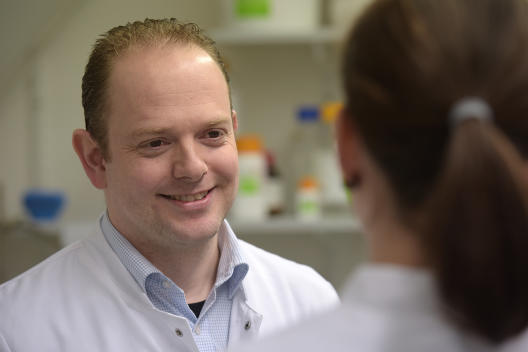“My aim is to treat malignant lymphomas at the molecular level”

What scientific topic are you working on right now?
My research team and I are working on a molecular characterization of malignant diseases, focusing particularly on malignant lymphomas – which are special types of lymphoid tumors – in order to offer more specific treatment strategies to affected patients. To this end, we are studying molecules and signaling pathways that are responsible for lymphoma development. We are currently focusing on inhibiting these pathways. Unfortunately, that is not as easy as it sounds. We have, however, already identified several signaling pathways that are essential for the survival of lymphoma cells. At the University Hospital Münster we are currently aiming to inhibit these pathways in clinical trials, and are working to get closer to a specific – which means more individualized – therapy for patients with malignant lymphomas.
What characterizes you personally as a scientist?
I started my scientific career as a medical doctor in Munich. Afterwards I have spent several years in the USA. From 2009 to 2014 I was at the Charité in Berlin, lastly as Senior Physician at the Medical Clinic for Haematology, Oncology and Tumor Immunology. Besides my work as a physician I have also worked in the laboratory in the last 17 years studying the molecular mechanisms how malignant lymphomas develop. My wife and I and our two children have been living in Münster for a year now. We really liked Berlin, but as a city Münster also has a lot to offer.
What’s your great aim as a scientist?
It is my scientific goal to significantly improve the therapeutic strategies of patients with malignant lymphomas. To this end, we need a better understanding of how such a disease arises. This will fundamentally change the therapeutic strategies that we apply. If we will be able to characterize precisely the molecular properties of the disease for each individual patient, we will be able to treat the disease at the molecular level. This will increase the cure rates and reduce the side-effects arising from our treatments.
What’s your favorite “toy” for research – and what can it do?
We carry out so-called small hairpin RNA library screens, which enable us to downregulate several specific genes of our choice and analyze the biological consequences.
Can you remember your happiest moment as a scientist?
That was the discovery of activating mutations in the NF-kB signaling pathway in diffuse large B-cell lymphomas. This discovery revealed to us that this signaling pathway plays a crucial role in the development of this disease.
How much artistry, creativity and craftsmanship is there in your scientific work?
My research consists of a mixture of a lot of work, new creative ideas and novel methods which we develop together with our scientific colleagues.

